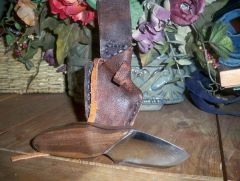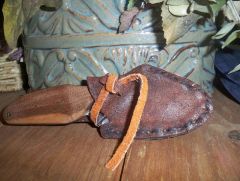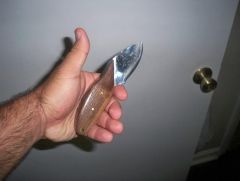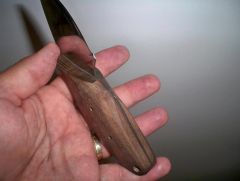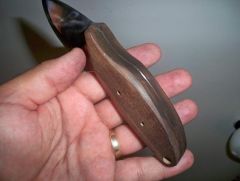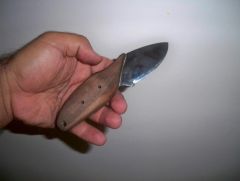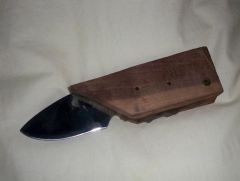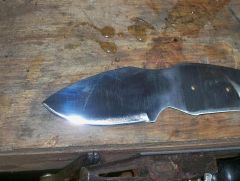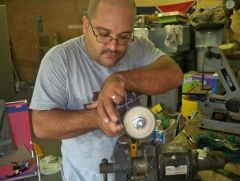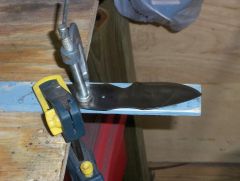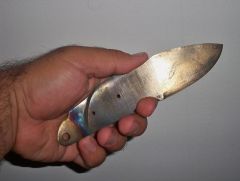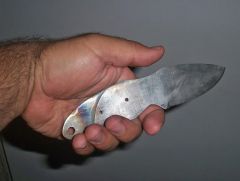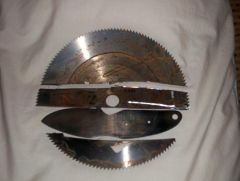
nashdude
Members-
Posts
92 -
Joined
-
Last visited
Content Type
Profiles
Forums
Articles
Gallery
Downloads
Events
Everything posted by nashdude
-
I started my knife shop on her maiden voyage yesterday and ground out (yes, ground---no forge yet ) a pretty decent blade. I've got a deer antler ready to go on the end of the tang, but I was wanting to finish it up with a brass guard, preferably a hunk that's somewhere in the neighborhood of 1x2x2. Thing is, I got NO CLUE where to scrounge for brass. A buddy of mine found some cheap brass "door treatment" at a local hardware store, but no joy at mine. Suggestions? Thoughts? Outside the box?
-
Welp, scratch that idea I got me a (much needed) Delta SA180 from a friend this afternoon, and went out to my shop to make a place for it. While I was out there, I got to thinking about the scrap piece I was going to use for my razor. So I put it in the one-brick forge and brought it to non-mag. I took it out to let it cool, then set up my Delta. By the time I got done and took another look at the scrap, I noticed a diamond shape around the hole that I hadn't noticed before. Yep, you guessed it. As soon as the metal cooled, that diamond piece fell out, leaving me just a couple mm's of metal holding the would-be blade to would-be tang. Needless to say, I was ticked. :mad: Anyway, scratch one straight razor... at least for now. I've got a piece of antler I've been dying to affix a blade to anyway, so I'll come back to this later.
-
Glad to have you back :)
-
I can answer this much... no carbide tips. Whatever steel it is, it's at least the same steel the full length of the blade. There IS a raised section in the center, around the hole, but I think it's just more of the same type of steel. How does one go about IDing it? Almost HAVE to try to! I mean, what's the point in slamming one of these things together if I don't take the plunge and see if it was worth it? Granted, that means I'm gonna be flying solo on my maiden voyage---I'm a lifetime safety razor man---but if I'm gonna step up and "go straight", I think it's rather fitting I do it with a blade of my own design. Hehe thanks. Yeah, by the look of it, the HT is gonna be all-important. It can mean the difference between a STRAIGHT straight razor and a wavy one.
-
Ummmm... steel? Honestly, I don't know. I just know it was a standard wood blade that was of no further use in its original state.
-
Now that I have my one-brick forge going, I'm ready to get in my shed and DO SOMETHING! But since I haven't got up the money to get a belt grinder yet, nor set up a REAL forge, nor transformed my RR rail into an anvil, my options are kinda limited. So I'm rummaging around my scraps and came across a section of sawblade from my first stock-removal knife. It's the center piece in this pic... I'd put it in my one-brick a few days earlier for her maiden voyage, heating it to non-mag and thus achieving a milestone (yay me!), but hadn't thought much about it since. Then I got to looking at it, and noticed how EASY it would be to grind it into a straight-razor-like shape. I found this thread through Google, and it gives a lot of good information in there, but I'd really be interested in what yall have to say. So how's about it? Anyone here with a little hands-on I can draw from?
-
Complete newb observation, but I'd say it's because as a holder, the blacksmith can watch the striking in progress---adjust the forged item on the anvil as necessary, or call a halt to the striking, or what have you. When you're swinging a hammer, your attention is divided between detail and muscle, so I would imagine the smith as the holder would be about putting as much attention to detail as possible.
-
EXCELLENT! Thanks for the tip, Larry---it proved very fruitful. On a Google Search, this is what I found... EDIT: Also found this video on YouTube which demonstrates the above info. YouTube - How to tell the difference between cast iron and steel Again, thanks for the tip :)
-
Since I get most of my knife steel from old tools or junkyard/metal yard scraps, I could seriously use some tips here. And as I'm scroungin', I really don't have the resources to send the metal off to be tested Now, I know that you can tell pretty much any iron-based metal by its magnetism. Also, I know you can tell stainless steel from carbon steel by the type of rust that coats it. Stainless is generally dusty, surface rust. Carbon steel is generally a much harder rust---very little dust, a good deal of pitting. What I'd like to know is if there is any similar way to tell the difference between steel and iron? Is there any backwoods way to tell what metal is what?
-
-
-
-
-
-
-
-
First of all, congrats on forging your first knife! I'm still at the "one-brick forge" stage myself, so I've yet to attempt the ol' hammer and anvil, but it's coming, trust me :cool: Now then, I do have to take issue with one point... Ummm... why? Maybe it's just me, but the whole point to being a blacksmith/bladesmith these days is to turn trash into functional treasure. ANYBODY can buy a blade, but only someone with a heart for the art can MAKE their own blade. This is the challenge---to make something that is COMPLETELY YOU. So if you reached into those raw materials and dug out a blade that you're proud of, why would you "buy" the handle material to complete it? See, "nicer handle material" is all a matter of perception. In reality, that bar of steel was just a bar of steel, but you PERCEIVED a blade within it. Use that same perception on the world around you, bro. Become a scavenger!!! Check out the trees in your back yard, or the fallen limbs at the local park. Go to yard sales, looking for old wooden trophy bases. Go to the junk yard, looking for old tires. Heck, rip up some old blue-jeans, apply a little Bondo, and make your own Micarta! (Click link for tutorial) The point is, NEVER think that you have to "buy" something to make your blade look good. The materials, in large part, don't matter! What matters is the HEART that you put into the knife, and from looking at your first attempt, you at least got that. Don't sell yourself short by "buying" the end result ;)
-
I wonder how hard it would be to apply the principles to a WOOD build. I've got access to ALL KINDS of pallet wood, so I wouldn't be hurting for materials.
-
That is AMAZING, man! Such an original idea, and so masterfully done. Definitely set the bar higher with that piece.
